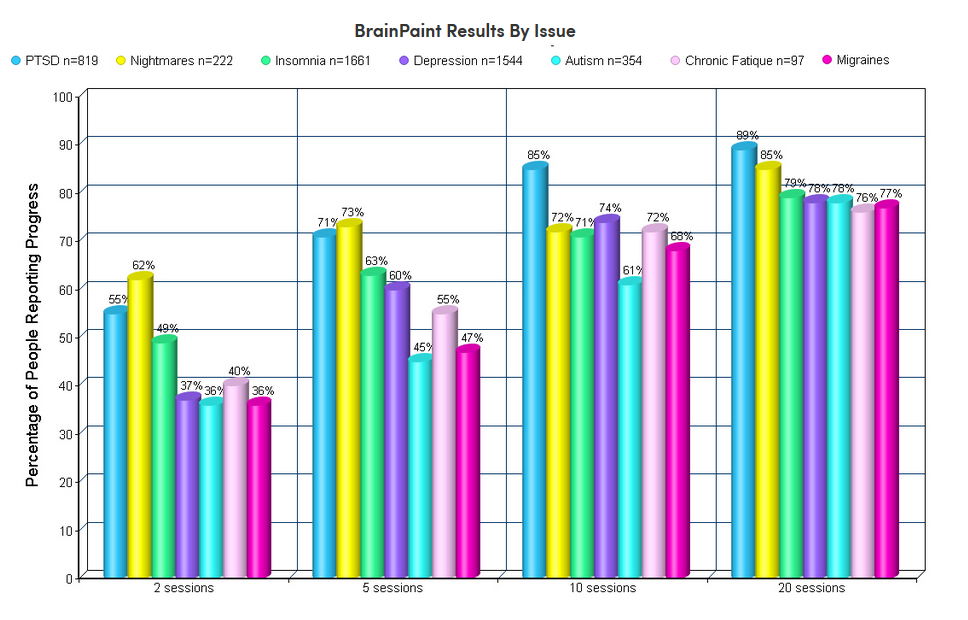What is Neurofeedback/Brain Paint?
From a study on Neurofeedback and Veterans with PTS:
Neurofeedback with anxiety and affective disorders
D. Corydon Hammond, PhD, ABEN/ECNS
In a Veterans Administration hospital uncontrolled study [74] , 20 Vietnam veterans with chronic PTS, all with comorbid alcohol abuse, were randomly selected.
All patients showed frequent (eg, two to three times per week)episodes of PTS symptomatology and had been hospitalized for PTS an average of five times. They were treated with 30 30-minute sessions of alphatheta neurofeedback training.
Follow-up interviews occurred with the patients and their wives or family members on a monthly basis for 26 months. In that time, only 4 of the 20 patients reported a few (one to three) instances recurrence of nightmares or flashbacks, and the other 16 patients had no recurrence of PTS symptoms. The status of alcohol symptoms was not reported. According to the biofeedback efficacy criteria, neurofeedback treatment of PTS qualifies for the status of probably efficacious.
Detailed Article on the Benefits of Neurofeedback:
Neurotherapy: Using Biofeedback for Difficult Health Problems
Graham J. Patrick, PhD, CNS, ARNP, BCIAC
Topics in Advanced Practice Nursing eJournal. 2002;2(3)
It is well recognized that biofeedback treatment offers short-term, cost-effective approaches for problems such as chronic pain, irritable bowel syndrome, insomnia, incontinence, and asthma. These problems may be resistant to the conventional medical care available in most primary care settings. A novel electroencephalographic biofeedback application, known as neurotherapy or neurofeedback, is now being used to treat problems such as traumatic brain injury, epilepsy, depression, anxiety, chronic pain, chronic fatigue, and attention-deficit/hyperactivity disorder. Advanced practice nurses should have a basic understanding of the scope and limitations of biofeedback and neurotherapy so they can refer patients to trained clinicians as primary and adjunct therapy.


Many people who exercise take their pulse before, during, or afterward and use changes in their heart rate as a way of measuring their physical workout. Most of nursing, in fact, involves using physical parameters, such as temperature, heart rate, blood pressure, and other markers, as indicators of pathologic conditions or measures of treatment efficacy. The information provided through physiologic measurement can also be used to teach patients to modify their health behaviors to achieve some control of their health. Several successful biofeedback protocols are similarly used and take advantage of patients' abilities to learn to regulate their internal environments through the use of appropriate feedback.
In clinical biofeedback, practice instrumentation and computer technology are used to help patients identify their heart rate, blood pressure, muscle tension, skin temperature, or other physical responses. Abnormalities in these parameters are often associated with pathologic conditions such as chronic anxiety, hypertension, low back pain, Raynaud's disease, and other problems. The goal in biofeedback training is to help clients tune in to their body responses and associate those with certain key aspects of their psyche, such as beliefs, thoughts, and emotions.[1] Biofeedback thus involves helping clients tune into and listen to their bodies. This body awareness has many beneficial implications. Clients can learn to change their psychological responses and thus gain control of the associated physical symptoms. Success at changing the responses is also reinforced by bioinstrumentation.[2] Research indicates that the brain areas activated during biofeedback training may be the same ones used when clients learn to reduce arousal.[3]
The biofeedback process uses noninvasive sensors designed to detect a biophysical signal such as electromyographic muscle activity, electrodermal skin resistance, peripheral skin temperature, pulse rate, breath volume, sphincter muscle tone, or, in some newer applications, the electroencephalographic (EEG) signal. The sensors generally act as transducers that change the biophysical activity into an electrical signal. Digital instruments are used to interpret the electrical signal and separate true signal from artifact using amplifiers and filters. The resulting digital signal is then usually sent to a personal computer, and the information is presented as graphs, audio tones, or, in some cases, video games controlled by the biophysical signal.[2]
Biofeedback practice is holistic in that its focus is on the needs and functions of the body, mind, and spirit as an integrated whole. The actual therapeutic process used in biofeedback is self-management. Self-management involves helping a patient identify his or her own goals in terms of a particular problem. Through the use of therapeutic contracts, biofeedback instrumentation, and cognitive behavioral techniques, the patient is helped to change behaviors, feelings, and thought patterns associated with the patient's own identified problem. The biofeedback instrumentation helps the patient listen to the body and make the connection between his or her arousal patterns and stressful events. The patient is also helped to identify how those events are interpreted and any associated physiologic problems the patient has developed. The focus is generally on helping the patient identify and use his or her innate strengths and not on weakness or pathologic conditions. Thus, the patient works toward goals he or she has chosen and experiences rewards that have been earned, which reinforces behavior change and associated feelings of success.
Biofeedback treatments have been used for more than 30 years to treat problems such as tension headache, insomnia, anxiety, hypertension, muscle fatigue, incontinence, chronic pain, and, more recently, certain cognitive or behavioral problems, such as learning disability, posttraumatic stress, and addictions. Recently, there has been an attempt to teach patients to monitor the activity of the brain indicated by the EEG signal. This type of biofeedback therapy is coming to be known as neurotherapy or neurofeedback.
The EEG signal consists of tiny fluctuations of electricity in selected frequency bands that result from the summed activity of neurons in the cerebral cortex. The voltages are measured in 1 millionth of a volt or microvolts. The frequency bands vary from 0 to 40 or more Hz (cycles per second).
The standard for locating electrodes on the scalp is the International 10-20 System. This system uses certain landmarks, such as the nasion (front) and inion (rear) on the head, for placement of electrodes to ensure accurate relationships to underlying brain tissue.[4] Conventionally, the EEG signal is obtained via 24 to 30 electrodes connected to the scalp with colloidal glue and connected to electronic instruments. Extreme care must be taken to prepare the scalp sites, because artifacts such as sweat can contaminate the signal. Usually the patient is told to open or close his or her eyes while measurements are taken. Occasionally, certain other procedures are performed, such as having the patients hyperventilate, exposing them to flashing lights, or withholding sleep.
Neurotherapy is based on collecting the EEG signal and using the signal as a biofeedback medium. This may seem to fly in the face of the conventional use for EEG data. The goal is to help the patient recognize patterns in the EEG and any associated thinking patterns or behaviors. As in other types of biofeedback, the underlying principle is to use self-management strategies to help the patient take control of problematic symptoms,cognitive patterns, or behaviors.
Neurotherapy applications have been evaluated and proposed as interventions for ADHD, addictions, anxiety, depression, traumatic brain injury, and other psychiatric problems.

Learn about Dr. DiSiena who oversees Neurofeedback, Chiropractic and Nutritional Care:
Also find out about the Brain Wellness Seminars:
